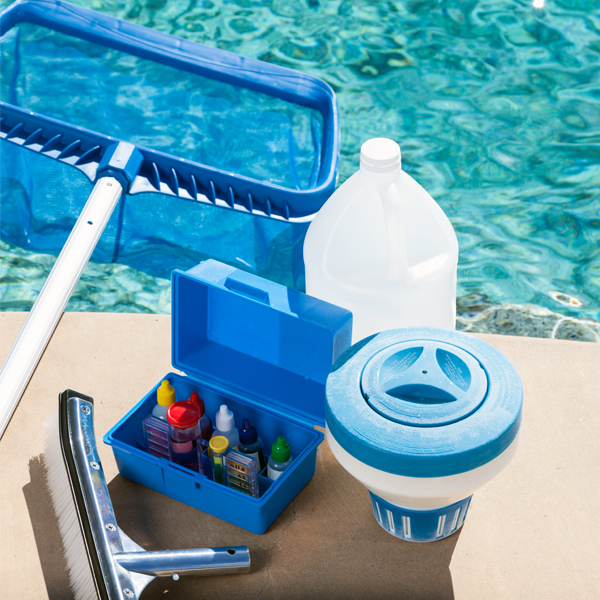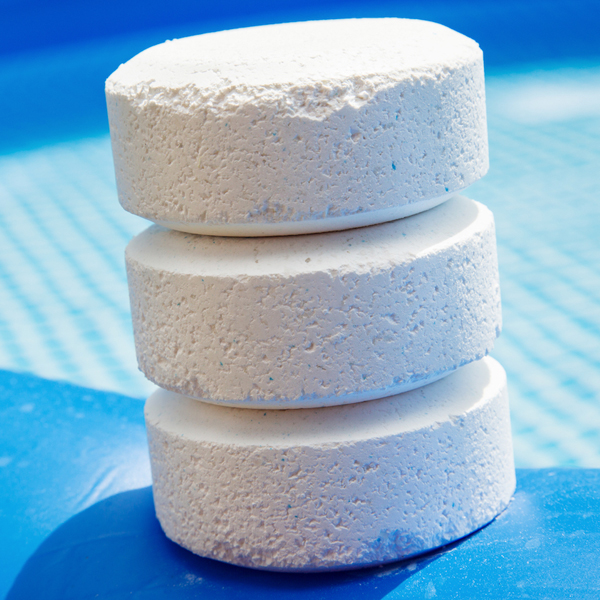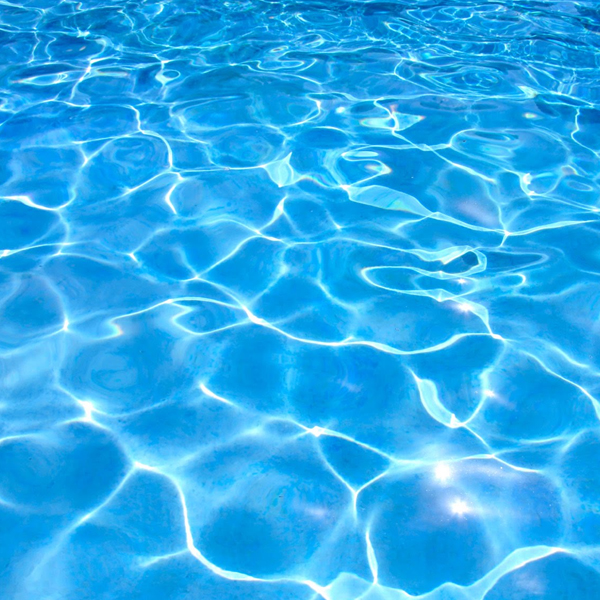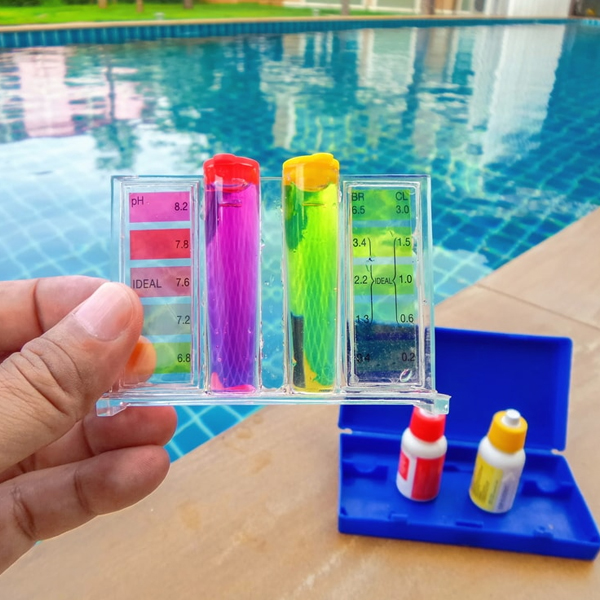The Must Knows Of Pool Chemistry
Advice - Pools
Owning A Pool Takes Some Work
Many of our new pool customers are slightly taken back when they find out the amount of work and maintenance that goes into caring for their pools. Life as a pool owner would be so blissful if you could just simply fill your pool with water, swim whenever you wanted and never worry about the chemistry of your water. However this is not reality, as the testing of your pool water and adding proper chemical treatments to it is vital to the health, usability and longevity of your pool.
Although at first new pool ownership may seem a tad overwhelming, once you understand the basics of pool care and pool water chemistry, owning a pool becomes a lot less stressful and a lot more fun. All it takes is basic chemical knowledge, consistency, the right equipment and effort to keep your pool spick and span.
For all of our new pool owners, and to those who need a little refresher, we have outlined our top pool chemistry basics in this blog. Specifically, the main pool chemicals you will need, how to add them to your pool, and any troubleshooting info that you may need to know. Follow this guide as a trusty source for tending to your backyard oasis.

Chemicals, Chemicals, Chemicals
It is inevitable that your pool will see some organic and inorganic contaminants. Leaves from a nearby tree, tanning oil from a swimmer, or dirt particles, are just some of the causes of contamination that can eventually wreak havoc on your pool if not properly treated.
To eliminate pool contaminants, you'll need proper pool chemicals. Sanitizer, being the most important chemical you'll need, will successfully eliminate unwanted materials in your water. However, in order for your sanitizer to do it's job properly, your pool water chemistry will need to be balanced.
Your pool's pH, alkalinity, and calcium hardness will need to be at the recommended levels in order to be able to properly pair alongside your sanitizer for a powerful, thorough clean.
Sanitize, Then Sanitize Some More
Eliminating your pool of damage-causing contaminants is important for the longevity of your pool equipment, pool liner and for swimmer safety. Familiarize yourself with sanitizers!
Chlorine
Our most popular pool sanitizer to date has been chlorine. Chlorine is a trusted germ destroyer because it is able to thoroughly penetrate the harmful molecules in your pool and eliminate them. Chlorine is effective at killing viruses, bacteria, organic contaminants and will also help prevent algae growth; which is something you definitely don't want to happen!
Chlorine comes in three forms, granules, liquid and tablets.
Granules
With granules, you will pour them directly into your pool water, where they will then dissolve and distribute amongst your pool’s filtration system. With granules, you'll need to make sure that they are evenly distributed. To play it safe, wait 3-6 hours after adding your granules and then jump in for a swim. Did you know that swimming can be helpful for mixing your pool's stabilizer more thoroughly?
Liquid
Liquid chlorine has a higher pH level than it's powder form. Liquid chlorine is primarily used in pools with a lot of activity, and is typically cheaper than powder. Liquid chlorine is also unstabilized, so if you have an outdoor pool, you'll need to add cyanuric acid with it to protect it from the sun.Tablets
Chlorine tablets are typically added to a floating chlorine dispenser (such as the HTH Tab Floater), directly into your pool’s skimmer basket, or to an automatic chlorinator (such as the Hayward Chlorine Feeder).
Any equipment used with chlorine tablets will typically provide more even distribution than that of just straight liquid chlorine or granules. However, we highly recommend that you use an automatic chlorinator to achieve the best dispersion rate, to handle the tablets less often, and to save you time!
The ideal chlorine level in your pool water should be 3 parts per million (ppm). Anything less than this could mean that your pool water isn't completely clean. Any level higher than 3 ppm, means you'll need to dilute your water with a neutralizer. Since chlorine is so powerful, too much can be harmful for your liner and swimmers. Always regularly check your chlorine levels!
Did you know that there are two types of chlorine? Stabilized and unstabilized chlorine!

Stabilized Chlorine
In order to prevent the sun from burning off the chlorine in your pool water, you'll need stabilized chlorine. Stabilized chlorine contains cyanuric acid, also known as stabilizer, that works to protect the chlorine and keep it in the water longer. This will save you time and money!
If the chlorine you buy doesn’t specifically say “stabilized” on the label, please refer to the active ingredients list. If you see Trichloro-S-Triazinetrione or Trichlor, you are good to go!
Unstabilized Chlorine
This type of chlorine is vulnerable to the sun’s ultraviolet rays, as it does not contain any cyanuric acid, and is more typically used in indoor pools. We see many hotel pools opting for the unstabilized chlorine option as there is no risk of racking up too much cyanuric acid in the pool water.
Too much cyanuric acid will require pool owners to drain their pool and start fresh if they are unable to dilute it!
Cyanuric Acid
The ideal cyanuric acid level in your pool water is 100 ppm or less. During the oxidation process, chlorine dissipates and eventually becomes a waste product called chloramines.
You know that distinctive "pool smell”? It’s not the chlorine, it’s the chloramines! Chloramines are what sting your eyes and dry your skin when you swim. To keep chloramines under control, you must add chlorine to your pool on a regular basis. You will determine how much chlorine your pool water needs by testing your water regularly and taking in consideration the size of your pool.
Not only should you regularly test your pool water, but you should regularly shock it as well. Shocking your pool, also commonly referred to as super-chlorinating your pool, is the practice of adding a high dose of chlorine to your pool all at once. This is beneficial for ensuring that your pool water is clean, and for algae prevention.
You can use chlorine to shock your pool or, you can opt for pool shock. Pool shock is made with unstabilized chlorine or no chlorine. We recommend that when using pool shock, that you use it at night to avoid the sun's harmful UV rays. When you use shock at night, it will work while you sleep so you can swim the next morning!
Bromine
The most popular alternative to chlorine is bromine. Bromine's main function is to work by effectively breaking down the chemical bonds of contaminates, thus destroying them. One of the main reasons pool owners opt for bromine is that bromine typically lasts longer in a pool as it does not break down as easily as full chlorine products.
The ideal bromine level in your pool water should be 5 ppm. If your bromine level drops below 3 ppm, you need to re-balance your water with more bromine as soon as possible.
Minerals In Your Pool
Minerals are always beneficial, but only in smaller doses. Pools require the use of mineral based products alongside your sanitizer. The main minerals you will see in your pool's mineral based products are silver and copper.
Silver is a known bactericide, and copper is sometimes used as an algaecide. When these metals come into contact with water, they release positively charged ions, which work to destroy negatively charged contaminants. Mineral sanitizer systems may also include borates and magnesium chloride as active ingredients, which also have algae fighting properties.
It is important that you understand that mineral based chemicals aren’t "total package" sanitizers. You will still need to utilize other cleaning agents in your pool!

pH
pH refers to the measure of alkalinity and acidity in your pool. The pH scale ranges from 0 to 14, with 7 being neutral and your ideal level number. Any measurement below 7 is considered acidic, and any measurement above 7 is considered too alkaline, or "basic".
Anything that enters your pool, organic and inorganic, can directly influence the pH level of your pool. Therefore, it is very important to stay on top of your pool’s pH level to make sure that it stays in the recommended level 7 range.
To efficiently balance your pool's pH, we recommend that your grab yourselves a bucket of pH Up and a bucket of pH Down.
We recommend that you keep your pool's pH level within the 7.4 to 7.6 range. A balanced pH means that your sanitizer is able to work more efficiently!
Calcium
No, we are not talking about the nutrient that is beneficial for bones here. Calcium refers to the measurement of how hard or soft your pool water is. Although calcium hardness may vary depending on your geographic location and your source of water, if the calcium level in your water is too low, it can lead to the scaling and corrosion of your pool's walls and equipment. If this happens, don't panic as it can be corrected with a calcium hardness increaser.
If your calcium level is too high, you may end up with cloudy pool water. If this happens, it can be fixed by shocking your pool followed by adding a clarifier.
We recommend that the ideal calcium hardness level in your pool water remains within the range of 175 ppm to 225 ppm.
Eliminate & Clarify
Algae growth can be a very intimidating problem to pool owners. Keeping the chlorine level balanced in your pool will typically keep algae at bay. However, sometimes you will need a phosphate destroying product and a good-quality algaecide to as back up. The build up of phosphates is what typically causes algae growth in your pool. We recommend that you keep a bottle of Algaecide and PhosFree on hand at all times.
In the event of an algal bloom, we recommend that you first shock your pool followed by using an algaecide to keep the algae from continuing to grow and spread. After your pool water returns to normal, adding in a phosphate eliminating chemical semi-regularly will work to ward off algae-causing phosphates and can prevent algae growth from occurring again.
Test That Pool
Knowing which pool chemicals to use regularly and in dire situations is critical. Before you add chemicals, please test your pool water. After bad weather (such as a heavy rainfall), or after a pool day with multiple swimmers, please test your pool water!
The most efficient way to test your pool water is to purchase a complete water testing kit or, by using a digital water testing reader and testing strips. However, if you are ever stuck, we offer FREE pool water testing at our water lab(s). Our water lab experts will be able to let you know exactly which chemicals you need and the amount that you need to add in order to re-balance your pool water.
The more you stay on top of your pool water chemistry, the less problems you will have. Taking 15 minutes every couple of days to regularly test your pool water will save you time, water and money; and can even extend the longevity of your pool!


